 |
|||||||||
Classical Editor: Rob Barnett
Music Webmaster
Len Mullenger:
Len@musicweb-international.com
|
Classical Editor: Rob Barnett
|
||||||||||||||||||||||||||||||||||||||||||||
|
|
April 1999 |
|
|
|
||
© Music on the Web(UK) 1999. All rights retained. Reviewers retain copyright on their reviews. Disclaimer
![]() COMPETITION WIN
a CD of your Choice from Crotchet
COMPETITION WIN
a CD of your Choice from Crotchet
![]()

FastCounter by LinkExchange
Go to Part 2
Eugen D'ALBERT Tiefland Eva Marton; René Kollo; Bernd Weikl; Kurt Moll. Münchner Rundfunkorchester conducted by Marek Janowski
ARTS 2CD 47501-2 (134:46) superbudget price
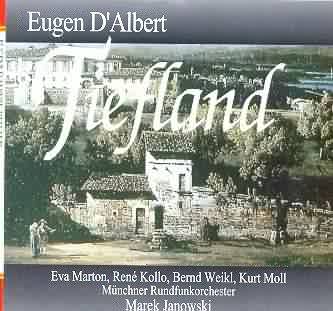
My curiosity about this opera was fired when I noticed a number of references to it scattered through the life of Erich Wolfgang Korngold in Brendan Carroll's biography, The Last Prodigy. When Korngold was only nine years old he composed a cantata for solo singers, chorus and piano entitled Gold, the opening of which showed the influence of Tiefland. Then, Korngold resigned his professorship at the State Academy in Vienna, in 1931, because his perfectionism would not allow him to tolerate a particularly embarrassingly poor orchestral rehearsal of Tiefland by the institution's indolent pupils. Finally we learn that Hollywood exile, Rudolf Lothar, the librettist of d'Albert's Tiefland contributed to the story for Korngold's Die stumme Serenade (The Silent Serenade) first performed in March 1951. So, thinking that whatever influenced the opulent Romantic style of Korngold was worth pursuing and having been impressed with D'Albert's Piano and Cello Concertos, I invested in this super-budget Arts release. I was not disappointed.
Eugen D'Albert was born in Glasgow in 1864. He bore a French name of Italian origin, was German by adoption and died a Swiss citizen in 1932 in Riga! His parents moved south to Newcastle when he was very young and he was drilled as a public pianist at a very early age. He hated England and after several years in London made his way to Vienna at the age of 17. He composed 22 operas taking in every "problem" story ever tackled in opera from Wagner to Krenek's "Johnny spiel auf". Tiefland (1903), in the Italian 'verismo' style, shows influences of Wagner and Richard Strauss and there is much use of Viennese waltz forms. D'Albert's orchestration is sumptuous. It is set in Spain; partly on an isolated mountain slope in the Pyrenees and partly in a lowland valley in Catalonia. D'Albert always keen to soak up local colour and atmosphere, went on a walking tour of the region and had a musical scholar obtain Spanish dance tunes and shepherd's call s for him. For D'Albert, authenticity was an integral part of naturalism.
The drawback with this 2 CD set is that although there is a substantial enough booklet with good notes in English, French and German, the libretto is only in German so unless the listener is fluent in that language, it is impossible to appreciate all of D'Albert's subtleties and nuances. Briefly, the story concerns a rather naive and lonely young shepherd, Pedro who is persuaded by landowner, Sebastiano to descend from his mountain home to the plains below and to marry the lovely Marta.
Marta is Sebastiano's young ward and mistress. Sebastiano has an ulterior motive because he wants to make a good profitable marriage to bolster his dwindling assets - but he also wants to keep Marta as his mistress. At first Marta is repulsed by the guileless Pedro who she thinks is a rogue but when she realises that he is innocent and really loves her, she falls in love with him when she discovers Sebastiano's deception. Pedro and Marta confront Sebastiano with their love but he will not let Marta go particularly as he knows that he has now lost everything because his intended bride has also been told of his duplicity. In the ensuing fight between Pedro and Sebastiano, Sebastiano is killed and Pedro and Marta flee for the purer atmosphere of the mountains.
The cast is impressive in this 1983 recording. René Kollo is as magnificent as he was as Walther in the 1971 Karajan recording of the Die Meistersinger as he ranges from incredulous innocent, to ardent lover, to vicious avenger. Bernd Weikl is also excellent as Sebastiano, the scheming villain with a heart. Eva Marton also impresses as Marta but curiously the important role of Nuri is not credited in the booklet's cast list (although more minor characters are!). The best material is given to the men. Highlights include: the evocative orchestral opening vividly portraying life in the high mountains; the Act I scene when the village maidens make fun of what they perceive as the boorish naivety of Pedro and Marta's anxiety about being separated from Sebastiano against lively Richard Strauss/Viennese-like material followed by Sebastiano's Ochs-like reassuring serenading of Marta to similar material found in Der Rosenkavalier but with more passion and irony (the orchestral accompaniment at the end of this scene is positively ravishing). Act II highlights include Pedro's big aria the wolf song in which he tells Marta of the wolf he had killed on the mountains to protect his sheep (serving as an allegory for the situation between Marta, Sebastiano [the human wolf] and himself); this is followed by the glorious love duet between Marta and Pedro as Marta realises the truth of the situation.
Janowski leads his his choir, orchestra and soloists in a passionate and moving performance of this much negelected opera - little wonder that it had such an effect on Korngold! At such a bargain price this is an operatic set that everyone who loves full blooded late Romantic music should snap up without hesitation.
Reviewer
Ian Lace
tar.gif)
MALCOLM ARNOLD (1921-) Overtures:- A Sussex Overture (1951) 12:11 Beckus the Dandipratt (1943) 10:45 The Smoke (1948) 11:56 The Fair Field (1973) 9:17 Commonwealth Christmas Overture (1957) 18:55 LPO/composer
rec 14-16 August 1991, Watford Town Hall Producer: Christopher Palmer [all premiere recordings apart from Beckus] REFERENCE RECORDINGS RR48CD [63:23]
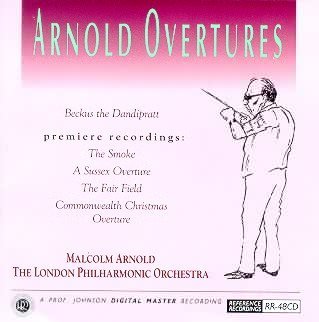
When this disc was first issued in 1992 it attracted some attention but has been lost from sight in the drifts of new releases. This is a pity as the CD contains four premiere recordings. If memory serves these are still the only recordings of four of the overtures.
The Lyrita CD of the Fourth Symphony (made five or years before these) demonstrated the composer-conductor's slower interpretative approach. Contrast this approach with his EMI recording of Symphony No. 5. Many did not like this. That said, I rather enjoyed the Lyrita disc despite, or perhaps because of, the long lines and extended emotional intensity - a very Mahlerian approach which seems to have settled on the composer's shoulders in older age. It is stunning how much detail comes across in that performance. These Reference Recordings interpretations are projected with a similar steady pulse but trembling excitement is never far away.
A Sussex Overture is perky celebratory affair: new brightly-minted mornings. This is set against a desperate heroism and a valiantly beautiful endeavour of a tune at 1:50. The crowning glory of echoing fanfares (2:43) and many other passages remind you of the Symphony No. 5 of ten years later. Other highlight episodes include: 'ticking' flutes counterpointing a bumbling tuba (3:48); Sibelian 'chuntering' (4:11), a Holstian tread (6:30), at 9:01 the echoing horns of the Moeran symphony and Baxian (Symphony No. 5) woodwind calls. This work has all the quicksilver moods and lambent display of a miniature concerto for orchestra. Perhaps the invention becomes a little stilted at the end although even this is redeemed by the return of the heroic endeavour theme in the closing pages.
Beckus was never a favourite of mine. Here there are compensations: Loud boozy fanfares, 'spick and span' trumpet playing with a skirl and a slur. This is a Till Eulenspiegel of a piece. Its chaotic uproar comes over as rather disjointed and perhaps the tendency to slower tempi is noticeable.
The Smoke caused some scandal because of its jazzy references when first performed in the late 1940s. Jazz (Gershwin 'hits town' more than once) is certainly there but so is Broadway or more accurately The West End. Exuberance is the quality you associate with this piece as the explosive brass skirl, hiccup, leer, snarl and lavishly slalom their way through the piece.
The Fair Field is dedicated to Arnold's great friend and collaborator, William Walton. The point of departure is a fairground roundabout of a theme with vividly painted wooden horses grinning and the boys eyeing up the girls. The air of childhood innocence and of newly-minted mornings is there also promising excitement and adventure. The griping, gripping brass are a frequent presence below the garish colours and these 'anchor' the texture. A thunderous exercise: cheeky and sly like a saucy seaside postcard. The final moments include a slowly-glowing sunset.
Lastly we come to the (musically) strongest piece in the collection. The Commonwealth Christmas Overture is a piece I have known for years from a 1960s radio relay (LSO/Alexander Gibson). The Gibson still sounds very good and marginally (as a performance) I prefer it to the composer's version however it is no match in recording quality for References sweep-the-board recording quality.
What an overture this is! For me it is up there with another underestimated British overture (recorded once on EMI - Vernon Handley): Bliss's Edinburgh Overture. The Arnold's Waltonian splendour is undeniable. If you like Orb and Sceptre and Crown Imperial you must have this. The overture plays for almost 19 minutes. In that time the composer constantly pelts ideas at you and does so in stunning variety. Borodin's Prince Igor was not far from the composer's pen in the echoing brass fanfares. There are dashing and sliding flute glissandi, sea chanties (2:30, 16:31), English country dances (no bleached smocks, thank heavens!) and magically 'Christmassy' gamelan textures. The West Indies is evoked with electric guitar and maracas in a tune which almost (but not quite) becomes 'O my island in the sun'. The use of electric guitar foreshadows his 1970s experiments with the group Deep Purple. CCO is one of the glories of the British orchestral display repertoire and well worth getting to know. It articulates Arnold's unbounded and bounding inspiration for orchestration at the beck and call of musical values.
The recording quality on this CD is of stunning immediacy serving the music rather than the reverse. The project is a happy stroke of genius from Reference, the late Christopher Palmer (how we feel his absence!) and, of course, from the composer. Musical values clearly swept the board in all project decisions.
The eleven pages of (English only) notes are provocative and full of insights. Chris Palmer is the author. There four stills of the composer from the recording sessions and 2 drawings by Terry Williams. Warmly recommended for any collection of Arnold and any collector of British music. This is not a shelf item but one which cries out to be played.
Reviewer
Rob Barnett
tar.gif)
Visit the Malcolm Arnold Society pages
Kurt ATTERBERG (1887-1974) Symphony No. 7 - 'Sinfonia Romantica'; Symphony No. 8 Malmö Symphony Orchestra conducted by Michail Jurowski
STERLING CDS-1026-2
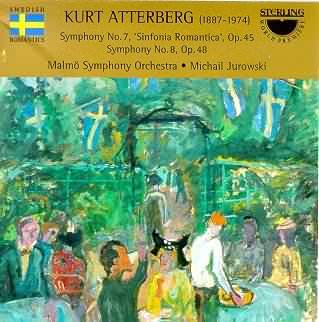
'...my seventh symphony, Sinfonia Romantica, a name which I chose out of irritation with the antic- romantics..." as Atterberg described it, was composed in 1941-42 and revised in 1972. At an informal meeting of three contributors to this site the spontaneous response was "doesn't this sound like Bax!". Indeed, admirers of the English composer will probably have no difficulty in relating to the red-blooded romanticism and rich harmonies and orchestration of this work (and to the other symphonies of Atterberg). This is the première recording of this symphony.
The Seventh Symphony opens with a rather dour fanfare that would seem to herald some tragic drama but the mood soon lightens and the tempo quickens to embrace the sort of heroic music one associates with Errol Flynn swashbucklers. There is also some opulent and languid romantic material and a few wry comic figures. The second Semplice Andante movement is ravishingly beautiful. I am reminded of the remarks of a commentator who described Bax's Second Symphony as one long love song; that description might be applied here but the music might also suggest a still and serene, lush landscape bathed, at the climax, in brilliant sunshine. The third movement, marked Feroce. Allegro, returns to bombast and, at first, it seems as though we are in Korngold's Sherwood Forest, but this is a wild melting pot of a movement, orgiastic with heroic/chivalric film score-like music plus march and dance-like material including a bucolic clog dance. At certain points, the music sounds quite Scottish and Irish and very Baxian. Interestingly, Atterberg's own words dominate the CD notes for this album and he relates how the basis of this symphony was his opera Fanal and how he wrestled with a fourth movement which he eventually discarded so that it could become a separate work in its own right - Op. 58 Vittorioso - yet he leaves it up to conductors' own discretion whether to use this music as a fourth movement. (It can also be tacked onto the composer's Three Nocturnes from Fanal). Maestro Jurowski choses to include only the first three movements.
Atterberg's Eighth Symphony (1944-45) receives its first CD recording on this album. It is based on Swedish folk motifs but the listener will notice a very close similarity to English folk material and indeed, the music reminds one strongly of Ralph Vaughan Williams in the jolly rollicking scherzo. Of this Symphony, Atterberg commented, 'When you happen to be encumbered with an uncontrollable urge to compose symphonic music, you cannot help it if your imagination runs away with you, and takes a melancholy little tune as the framework for a great symphony...This beautiful melody came alive in my imagination: sometimes it was sorrowful and rose red; sometimes - in its major key version - playful; and sometimes it was full of pathos.' - which nicely sums up the work except to say that the usual Atterberg heroic figures are also included and the finale is an exciting orchestral tour de force. Atterberg gives full details, in these fascinating CD booklet notes, about all the tunes he uses and how he incorporated them into this symphony. Jurowski propels the music strongly forward and reveals all the beauty of the more introspective and romantic sections. Strongly recommended.
Reviewer
Ian Lace
tar.gif)
Anton BRUCKNER: Symphony No.8 & Symphony No.9* London Symphony Orchestra / BBC Symphony Orchestra* Jascha Horenstein
BBC Music Legends BBCL 4017-2
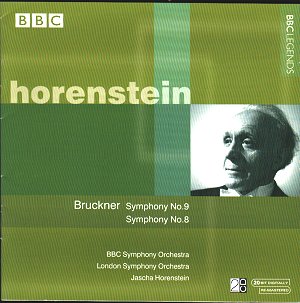
In his liner notes to this second Horenstein release on BBC Legends, Bernard Keeffe wonders why German-speaking composers dominated music in the eighteenth and nineteenth centuries. He concludes that in Central Europe where East meets West “earthy energy” became controlled and refined by “the intellectual discipline of sophisticated society.” He illustrates the effect of this by citing a Sibelius quotation that to get electric power you need a dam as well as a torrent and extends the metaphor to Jascha Horenstein’s conducting . Horenstein, too, was a product by birth and upbringing of these forces so is it surprising, Keeffe wonders, that his conducting reflects this—earthy torrent refined and controlled by the dam of a sophisticated intellect. An apt metaphor representing a delicate creative balance.
It would be easy to compare Horenstein’s Bruckner with that of other distinctive stylists, but I prefer to consider what Horenstein’s Bruckner is, rather than what it isn’t, in reviewing this live performance of the Eighth Symphony from the 1970 BBC Proms. Here are many of the characteristics that made Horenstein’s music making so distinctive applied to the greatest of Bruckner’s works.
A grasp of the structure across the entire piece and within individual movements and, most important, how each fits in one with another to make a satisfying whole without subsuming emotion and expression—rather, setting them in relief.
A healthy respect for, but not a slavery to, the passing moment, achieved by modular tempi set at the start, barely deviating and then only gradually and without jolting.
A terraced, chamber-like sound palette where each section is balanced equally but never loses its identity: an orchestra that is the sum of its sections and sub-sections rather than one organic piece.
Joins and edges allowed to show and contrast, a limb with bones, sinews, and blood vessels clenched for activity, not resting in repose.
The long breath.
No other phrase is adequate for Horenstein’s ability to manipulate his material (and in Bruckner this is a supreme gift) over the longest of spans to encompass within the broadest of paragraphs parameters of, at one extreme, despair that never becomes self-indulgent and, at the other, ecstasy that never becomes histrionic. That long-breathed approach means his own emotional compass points, which are often narrower than those of some of his colleagues, are kept in mind by the listener allowing all shades in between to be more deeply appreciated because they are heard in the round. In Bruckner, as in much else, Horenstein was the philosopher-actor able to bend his distinctive voice into what ever composer he interpreted and yet always remain himself, art concealing art. The first movement of the Eighth Symphony shows all these attributes. This is very serious, sober Bruckner conducting, the interpretation of a man wedded to the belief that the music speaks for itself. But it also manages to be grand and mysterious Bruckner, dramatic but not melodramatic. Notice, for example, how the approach to the movement’s final tragic climax is built with a stern inevitability so that when the last, bleak fanfares blast out across what, we soon realise, is an especially desolate landscape, there is nothing forced or mannered. It emerges from within what has been a closely argued conflict where Horenstein notices thematic links between each of the tiny musical building bricks of which Bruckner is master. Like that between the opening figure of the whole symphony and the ascending one after bar 51. This is a small detail but on such details great interpretations can hinge. If a conductor is alive to detail as concentrated as this, the same will apply to the larger picture.
The scherzo of Bruckner’s Eighth has always been, for me, another example of Horenstein’s ability to pitch a tempo that fulfils everything the music asks for. (It was just the same in his old Vox recording from the 1950s with the Vienna Symphony. One of his other attributes was creative consistency.) Neither too fast nor too slow, it has forward momentum but it also has weight. Amazing how few conductors achieve this. It’s a delicate balance but is, I think, the most easily illustrated part of this work where the “dam” and “torrent” analogy used by Bernard Keeffe is in evidence. Here is drama that becomes cumulative on each rehearing of the main material. The Trio, too, is a miracle of poise and delicacy. Again the overall tempo is perfectly chosen so this interlude doesn’t split the structure of the movement but it isn’t thrown away either.
There are slower, more intense, more overtly romantic readings of the Adagio to be heard than this, but I think few that understand an aspect of the music I believe is often overlooked. I have always believed this movement is a meditation, not a confession, and this is borne out in the long opening paragraph. Horenstein couches this in one of his longest breaths so that, after it has risen to its first climax and settled back on to its harp-accompanied calm, the transition into the second subject group is seamless and promotes a mood of reflection and serenity rather than soul-purging indulgence. There is some lovely cello playing from the LSO here also. This is remarkable for its simple presentation of the material unencumbered by exaggerated gestures from the conductor to interrupt our mood. Horenstein’s unwillingness to do anything that stands in the way of a careful and inevitable unfolding means that all the way through, we do become aware of a dark, unobtrusive, but very profound undertow taking us along. Horenstein trusts Bruckner to lead him. The final ascent to the great climax of the movement (with the two remnants of its Nikisch-inspired cymbals) is inexorable and massive for seeming to have its roots right at the start. It’s only having arrived here do you realise Horenstein’s direct approach has paid the greatest dividend of all. He also justifies, if justification is needed, those crucial extra bars the Haas edition contains at this point. Note also his care to make sure we hear the inner voices, the middle strings, and the woodwind, both of which can be subsumed beneath the brass.
I always feel Horenstein had a special affection for the long coda that follows the climax. I used to feel this in the old Vox recording from which I learned the work and the same applies here. Another conductor might slow down but by resisting this, Horenstein delivers not a requiem, as in the corresponding place in the Seventh Symphony, rather an impression of “well-being,” hard won. For me this emerges as the true emotional core of the work. This kind of treatment changes subtly the way the last movement is judged and, by the way he conducts it, I think Horenstein thinks that also.
Surely the secret of the last movement is not to try to force a unity on it. This is a movement that has an episodic character which, when viewed in context of the coda to the slow movement that precedes it, emerges as the least troubled part of the whole work. Horenstein’s unobtrusively tight grip on tempo and dynamics doesn’t desert him. Notice the great poetry he draws from the wonderful descending theme at bar 51. How often have I heard this taken too fast to lose its elegiac quality, or too slow and so hold up the long journey to the triumphant end still in the far distance. Then there is the great pounding wall of sound that follows it, where Horenstein is careful to make us hear clearly all the parts in the orchestra at a tempo that fits with the movement but which is powerful enough for it to stay in our minds. Once again, his mind is sufficiently on the bigger picture. And has anyone managed such a wonderful ascent to the figures on the flutes that seem to close an episode and point the way home, the strings coaxed into a wonderful whisper of sound as though the players are just showing their bows to their instruments? I also admire the way Horenstein holds back in the last climax but one, where the music builds and builds and then rears up to herald the emergence of the first theme from the first movement prior to the last ascent of all at the coda. This means that when the all-conquering coda to the symphony does finally arrive, again built up to a huge and impressive crescendo that puts in mind Horenstein’s recording of Mahler’s Eighth, it hasn’t been overshadowed as a lesser conductor might have inadvertently done. It only remains to say the four themes in combination that mark the conclusion of the work are clearly audible; and that is not as common as you may think.
I believe that night, whilst acknowledging the applause of the full house in the Royal Albert Hall, Horenstein lifted his score into the air in triumph—the sort of gesture he was not usually given to. He must have been pleased with this performance. The audience certainly was, and so must the LSO, which played what sounds to these ears a faultless performance, willing to do exactly what was wanted of them, never flagging in their concentration, delivering a real ensemble performance. In the first half of this concert the wind principles had already given a performance of Mozart’s Serenade No. 10 K.361, so must have played themselves in rather than tired themselves out, because the woodwinds are one of the glories of this performance.
The recorded sound is bright, sharp, and possessed of enough hall atmosphere for everything from the great climaxes to the most intimate ruminations to be heard. This performance has appeared unofficially on disc before, notably an aircheck contained on a Music and Arts release. There is not that great a difference between the two, though the new official BBC release from the master tape has the edge in being at a slightly higher level and closer in with more detail.
In the context of a Bruckner Eighth of this quality the live performance of the Ninth that accompanies it was always in danger of being overshadowed and, it has to be admitted, this is the case. It was given by Horenstein at the Royal Festival Hall in London just three months later with the BBC Symphony Orchestra and it should have been as good. But there appears to be something not quite right. Firstly, the orchestra play well but they don’t play as well as the LSO. It’s as if they are not as confident in what they are doing, that they have doubts—the way some of the horn entries seem tentative, for example. Whilst the ensemble is good there is an impression of the routine about it. Don’t misunderstand: this is still a fine example of Horenstein’s art with many of the attributes I have outlined to be heard, it’s just that he doesn’t deliver them as well. The huge crescendo near the start of the first movement is underlined with remorseless power and the warmer second subject has a world-weary quality that sounds fatally sick and world-weary, all as it should be. But I do wish Horenstein could have lifted his overall tempo a little more over the whole movement. The great climaxes sprawl, seem to lack some point, and so the concentration flags sometimes. This movement is not Bruckner at his greatest. Had he lived I’m sure there are passages he would have changed and the conductor and orchestra must be on their absolute mettle to justify what is there; I don’t think they are here, not one hundred per cent. True under Horenstein, the coda of this movement does gather material together well as if, belatedly, the performance starts to catch fire at last. This impression is borne out in the second movement which is given a masterful performance. As in the scherzo of the Eighth, there is weight, power, and movement with the wild brass entries really telling through the texture and the weird trio containing all the creepy detail you could want.
For Robert Simpson the last movement is Bruckner’s way out from the terrors of the first two movements enacted in a search for tonality: tonality as safety and safety as a farewell to life. Horenstein seems to agree and rises to the occasion, but I have heard more cataclysmic deliveries of the final crisis than this, and from whom? Well, from Horenstein himself. To hear what I was missing in this recording I had to look no further than Horenstein’s own 1953 recording for Vox (CDX2 5508 ) with the Vienna Symphony. Limited mono sound it may have, and less tonally splendid playing, but here is a Bruckner Ninth where every Horenstein attribute is splendidly realised. As in the Eighth, it’s won’t be to everyone’s taste, but it is all there that time. The tempi are tighter overall too with the whole reading coming in eight minutes faster than the London one. The edges are sharper and the moments of repose and serenity are in starker relief. The orchestra also seems much more in sympathy with what their conductor is aiming trying to achieve.
I wouldn’t want negative reactions to this Ninth Symphony to dissuade anyone from buying this BBC Legends set. You will still have in your collection a fine and distinctive performance of the Ninth, but you will have to set it against a truly inspired one of the Eighth. Great conductors, even on “off nights,” are worth hearing and can be preferred over lesser talents. However, if you want to hear Horenstein’s interpretation of Bruckner’s Ninth at its very best then the Vox recording (coupled with an early Mahler First) is the one to have. The sound of the Ninth on this BBC issue is very clear and close, like the Royal Festival Hall tends to be, but Bruckner needs a little more sonority and depth, more air around the instruments.
A crucial addition to the Horenstein discography, therefore, with one of his greatest interpretations which demands to be heard by anyone who loves this work and this composer.
Reviewer
Tony Duggan

&

CLEMENTI, Muzio. Piano Sonatas: F sharp minor Op 25 no 5; B flat Op 24 no 2; G minor Op 7 no 3; Op 25 no 6; F minor Op 13 no 6. Played on a Clementi square piano of 1832 by Peter Katin.
DDD Athene ATH CD4. [74' 35"].
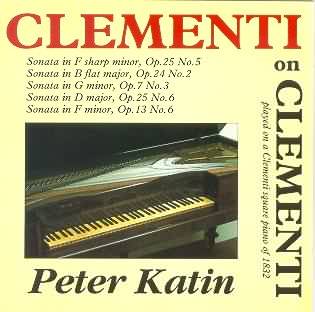
This disc is a delight.
I will not discuss the square piano as the notes with the CD do this admirably. What I want to do is recommend Clementi as a composer and give further indication, although this is unnecessary, of the unequalled stature of Peter Katin both as a pianist and musician.
Muzio Clementi was born in Rome in 1752; he moved to London in 1774 and died in Evesham in 1832. He promoted Mozart only to be repaid by Mozart's undeserved dislike of him ... which may put a different light on the Mozart - Salieri story. Clementi was a sensational pianist and a deservedly respected teacher. Among his pupils were Field, Moscheles, Kalkbrenner and Cramer. He composed symphonies, a piano concerto, about a hundred piano sonatas which were greatly admired by Beethoven and that, in itself, is some accolade! He was probably one of the first composers to write what might be described as 'educational' music with his volume of a hundred studies Gradus ad Parnassum. Debussy was to parody this in his first piece in Children's Corner. Interested in every aspect of music, Clementi went into the business of making pianos with the London firm Clementi & Company which, in 1832, became Collard & Collard.
The music has charm, elegance and wit ... and, thankfully, they are neither weakly delicate nor affected. They are strong but not demonstrative; they do not dream or linger or become tedious. The thematic material is always purposeful and never banal ... in fact, it is often memorable. The pieces have a wonderful sense of continuity; the music never gets bogged down. And I am convinced that Peter Katin's insight into the sonatas and his understanding of the music realises these qualities. Other pianists might play these works with that thistledown prissiness and baroquish lingering affection. As Claudio Arrau once said, "We observe rests in the music but we do not turn them into cracks."
The F sharp minor Sonata is enchanting. Music to fall in love with. It has a lyricism far ahead of its time and a melodic invention that is second to none. The slow movement unfolds as a telling lament and the finale takes a great amount of skill to execute containing fiendishly difficult passages in thirds. It is really a splendid piece. Pianists should take it up without delay and be thankful to Peter Katin for his pioneering work in bringing this, and other Clementi sonatas, to our attention!
The B flat Sonata was probably known by Mozart as he seems to quote from this sonata in his overture The Magic Flute. Is this plagiarism by Mozart? Incidently the G minor Sonata sounds like Beethoven's Eroica theme. Perhaps Mozart in his unmerited dislike for Clementi borrowed his theme as a sub conscious desire to equate himself with the older composer.
Peter Katin's finger work is faultless throughout and the opening movement of the B flat Sonata highlights this. In the andante he is successful in bringing out the music's attractiveness which is captivating. The finale is highly entertaining and the exciting bass line is imaginatively captured.
The G minor Sonata is not as well-written. The first movement seem to be understated with a series of scalic passages and a very pleasant melody that is constantly repeated. The andante is thoughtful and serious and what a wonderful interpretation Peter Katin gives it. This is the great difference between his playing and that of others. We have many fine pianists jetting all over the world playing with sure techniques and confident panache winning praise and, yet, while they are splendid executants some may lack the capacity to understand all the music's secrets, which only time surrenders, and therefore they can fail to reveal the music's hidden qualities. Peter Katin's playing has not been universally admired for 50 years without good reason.
The D major Sonata is another example of happy, bright music and while the music of the final rondo might be slender, Peter Katin captures its amusing quality.
The last sonata on this disc is the F minor and it is the most profound, reminding me of late Beethoven. It is dark music. The poignancy of the slow movement is obvious and the finale teems with activity.
To describe Peter Katin's performances would necessitate a host of superlatives.
Reviewer
David Wright
Performances

Recording

ALEXANDER GLAZUNOV (1878-1936) Grand Adagio in D minor from Raymonda (1897) * cond Vladimir Fedosyev rec 20 Jan 1983 Concert Waltz no. 1 in D major (1893) * cond Gennadi Tcherkasov rec 20 Dec 1978 To the Memory of a Hero - Symphonic Elegy (1881) * cond Vladimir Fedosyev rec 10 June 1982 The Forest - Fantasia (1887) Moscow State SO/Veronika Dudarova rec 18 Dec 1983 * Moscow RTVSO
all ADD ICONE Russian Masters Collection ICN-9424-2 [45:01] bargain price

This is a very mixed bargain price collection which because of its variety will focus you more on the music than on the artists. The common artists are Fedoseyev (Adagio and Elegy) who has a cycle of the Glazunov symphonies to his name and the Moscow RTVSO who appear on all but The Forest track. Tcherkasov and Fedoseyev are both natives of Leningrad as also was Glazunov.
The first track is the shortest at 4:37 and the longest is the last at almost 20 minutes. The Grand Adagio is rather intense but ultimately anonymous: polished and professionally balletic in the grand manner but not desperately interesting. The Concert Waltz is much more interesting being frequently rather Tchaikovskian. The whole thing is redolent of grand Edwardian hotels, pot plants, palms, tall sylph-like women in nodding feathered hats, a perpetual charming round of chatter and superficial romance. There is none of the complex psychological overlay that Prokofiev brought to the waltz years later. The notes mention the influence of Brahms and Dvorák but I could catch nothing of their voices just the romantic dizzy absorption of the dance. The Symphonic Elegy is an early work which I have never heard before. It is roughly contemporaneous with the first symphony. I wonder who the hero was. This is a work which begins in subdued charcoal lights with a dignified melody with a distinct ecclesiastical tone. This relaxes at 6:22 into a heart-easing tune rising to a rolling passionate climax at 7:05 and great calling brass at 7:22. From 9:03 the massed strings seem to call up memories of triumphant church bells..
The Forest is conducted by Dudarova (the only non-Leningrader) who was born in Baku. It is a romantically glistening work, rather rambling as befits a fantasy it certainly shows how much Glazunov had learnt from Rimsky-Korsakov. This forest is one of eerie magic (not the romantic Wunderhorn fantasy woods of Raff and Mendelssohn) but one populated by clarinet trills, a great trombone choir, troll dances and a storm. Mind you Glazunov’s storms have none of the elemental power of Tapiola (Sibelius) or even November Woods (Bax). In truth there were a few moments when I thought the tone-pictures were more marine than sylvan. While Glazunov had it in him to create grandeur (Symphony No. 8) there is no terror but lyrical release aplenty.
The whole package is well designed and documented with precise dates and venue (Concert Hall of Moscow Radio) of recording and reasonably informative anonymous notes (English only). What a pity about the short playing time. I recall a rather good Finnish Fantasy from the days of EMI-Melodiya LPs. Surely that recording was available. Technically the sound is not outstanding - perfectly respectable - having been Sonic Solutions No-Noised. Worth exploring. It would have scored higher if the timing had been more generous. If you have a spare five pounds you will make some real discoveries here; notably the last two tracks.
Reviewer
Rob Barnett

RIC GRAEBNER Works for tape. Venus in landscape (1995); Fulminar (1996); Resurge (1997); Divertimento of the Statues. Metier MSV CD92019.

"Electronic music is often treated in society as a prostitute," wrote a prominent American composer. "It is regarded as selling art and culture to satisfy a desire or whim."
There is a curious attitude that electronic music or music for tape is a sort of random selection of hum, wow and flutter, wobbles, hissing kettles, door bells, electronic alarms and bleepers and that it is all synthetic and inane just as a piece of modern art might be a one-coloured sheet of paper bearing an imprint of a bicycle riding across it once. That is not art for it involves no skill. Electronically acoustic music attracts that attitude. It is not music but electric current and knobs!
But here on this interesting disc we have four works for tape each lasting about sixteen minutes and they should be listened to as any other music. I hesitate to compare them with symphonic poems for that implies programme music and a narrative. What the audience will find is that most of the music is orchestral in sound or like a cathedral organ with a wide registration. Only occasionally do 'pure' electronic sounds appear, that is to say, sounds that cannot be produced by any orchestral instrument.
In these four pieces we have a splendid range of features of classical music: we have a 'toccata', a splendid 'adagio' with some beautiful music; we have frenetic excitement and remarkable effects. And it is not random guesswork or indiscriminate improvisation. There is clear planning and a logical coherence in this music.
Ric Graebner is of Anglo-Austrian stock and has written a Symphony, three string quartets, Thalia for two pianos, a Piano Trio, works for voice and ensemble and many other things. I found him an engaging personality, a courteous speaker and a true musician.
I recommend this disc to introduce people to music for tape. I am sure that the majority will find much to enjoy.
The recording is excellent.
Reviewer
David Wright
Recording

HAYDN. Piano Works. Variations in F minor, Hob. XVII: 6; Sonata in C, Hob. XVI: 35; Sonata in E flat, Hob. XVI: 49; Sonata in C minor Hob. XVI: 20. Joanna Leach (square piano)
Athene ATH CD2. DDD [68' 47"].
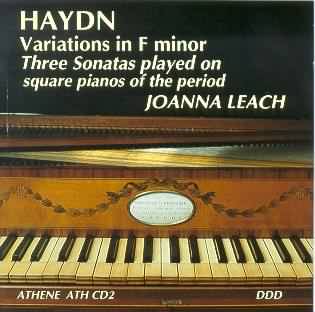
Joanna Leach is now in her early sixties and one wonders where her career has gone. She studied with Peter Katin the doyen and most brilliant of British pianists of the last 50 years. She is an accomplished player and her choice of tempi is to be admired. The Variations of 1793 is one of Haydn's most popular works and it is played here with a compelling sense of continuity and a classical beauty that is missing from performances by more famous names. The C major Sonata has an elegance and charm of its very own and is a very rewarding piece to play. Ms Leech's tempi and choice of ornaments is very convincing. I have never felt that Haydn's finale here works - a minuet in an allegro tempo - particularly when you consider Haydn's brilliant finales. The finale of the next sonata is also a minuet, although a more conventional one.
The Sonata in E flat is of historical interest since it was written for Maria Anna von Gensinger, the wife of the physician to Prince Esterhazy. Haydn had a close friendship with her and when she died in 1793 the Variations were composed. She was a good pianist and this sonata is introspective; it is a conversational piece and is almost operatic in style. It is a very personal and mature work. The slow movement is akin to a soprano aria which may reveal Haydn's feelings for Maria Anna. It is a fine piece, both peaceful and lovely with a tender yearning on the one hand and high drama in the minor key on the other. It is rather too florid and decorated for some tastes. While I do not wish to enter the arena to debate musical authenticity I feel that this rather special sonata fares better on a modern instrument as it will heighten the drama and have a wider range of tone. The heartbeats at the end of this movement say it all. The concluding minuet might suggest Haydn wanting to dance it with Maria Anna and enjoy her closeness. The two-part writing hints at two people in private.
The Sonata in C minor, like the Sonata in C, was written for Katharina and Marianna Auenbrugger, two sisters who were pianists. The C minor is a dark work and abounds in character and quality. The slow movement is far too ornamented for my taste but that is what Haydn wanted. Nevertheless, it contains a beautifully thoughtful main theme. Again, Jo Leach plays it in a direct manner and does not allow it to become sweet or sickly. The finale is restless and has more of a hint of tragedy in it.
And I am left wondering about what Haydn's real feelings were for Maria Anna and the Auenbrugger sisters.
The performances are thoughtful and reliable and it has proved to cause me to cogitate which must indicate Jo Leach's expert skill in communication.
Reviewer
David Wright
Performances

Recording

PETER KATIN in recital. LISZT Piano Sonata; BRAHMS Variations and Fugue on a theme by Handel Op 24; LISZT Sonetto 123 del Petrarca (Années de Pélérinage, second year) . Peter Katin (piano)
From a recital recorded in April 1983 at the University of Western Ontario, Canada. ADD Minerva Athene. ATH CD9 [67' 45"]
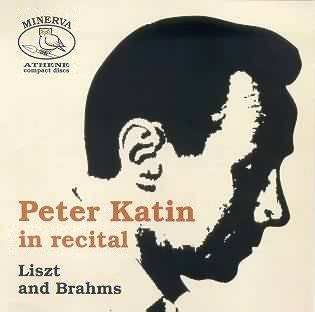
My admiration for Peter Katin is both well-known and well-founded. This may lead a cynic to castigate me as being prejudicial ... and, with this anxiety in mind, I decided to review this CD in a highly critical spirit. I placed the music before me accompanied by a pen and notebook to jot down any flaw, mistake or detail that I did not like. Seventy minutes later the notebook was blank and I had experienced not only a wonderful feast of quality piano music but performed with total accuracy and complete faithfulness to the score. It was a rare experience and yielded that inexplicable joy that only the greatest music and finest performers can render.
The use of language creates problems. There is no doubt that the Liszt Sonata is great music, one of the towering masterpieces of the piano repertoire. And then, I hear people talk about some of Schubert's piano music being great as well, and while I do not wish to disparage the melodious Schubert, one cannot possibly use the same adjective fairly for, in so doing, injustice will be levelled at Liszt.
This Sonata was introduced to me by my professor, Humphrey Searle at the RCM. Humphrey was, and probably remains, the world expert on the music of Liszt and we went through it bar by bar several times.
Katin's performance is exemplary and he observes all the detail in the score. The opening Lento assai is sotto voce and arresting. The allegro energico, beginning at bar 8, is exactly that and the bass marcato passages are precisely captured and when, in bar 19, the composer calls for agitato and, later, a crescendo and più crescendo that is what we get. Every phrase is beautifully shaped and the journeys to the big climaxes are always a natural progression of the music. At bar 23, we truly have sempre forte ed agitato and some dazzling finger work. The range of his staccato is quite amazing. At the first of the notorious double octave passages at bar 47 all we can do is be overwhelmed by the power and stunning playing and feel so humbled realising that we could never play like this, and at such a confident speed. The many distinguished pianists who 'fake' this passage with 'slowing downs', and falsely explain this as rubato are legion. To add to the formidable difficulties of the double octaves the composer later calls for it to be sempre staccato ed energico assai. And it is ... here. At bar 98 we have the 'big tune' marked grandioso. Fortunately, Katin does not vamp it as some pianists do, nor does he relegate it to Edwardian pomposity or medieval self-importance. Fifty bars later, at the cantando expressivo passage the wonderful warm romantic lyricism is expertly captured and when it reappears in octaves and in F sharp minor in the quasi adagio section the tenderness has a genuine beauty which is never allowed to become mawkish. There are many important details that listeners could pass over. For example, the long trills are beautifully controlled and so well-integrated. How many times have we heard lesser pianists make such an emphasis on trills as if it were a theatrical device.
Not only was Liszt writing in a romantic style but a classical style as well, as shown in the D flat major fugal passage marked allegro energico.
Peter Katin observes Liszt's stringendos which precede the fearsome double octave passages. How many 'great' pianists do not? ... and we know why. And the presto double octave passage leads to prestissimo still in double octaves and many pianists hardly reach an allegretto.
The recording is sixteen years ago and I have heard recordings with a brighter sound but the sound here is completely acceptable. I have heard some more exciting performances but they interpret Liszt as if he were a thumping circus performer and such readings are seriously flawed.
This superlative performance is class.
The Brahms is also faithfully played and with a rugged grandeur and infectious swagger. There is a smart and enviable elegance in another committed performance of insight which enhances this very fine work.
The Sonnet 123 is another performance of distinction and, as often with this pianist, it was a thought-provoking performance in its extraordinary and fascinating unfolding.
Reviewer
David Wright
Performances

Recording

see also David Wright's interview with Peter Katin
CONSTANT LAMBERT (1905-51) Pomona - A ballet in one act (1927) 19:45 Tiresias - A ballet in three acts (1950/1) 54:16 English Northern Philharmonia/David Lloyd--Jones
recorded Leeds Town Hall 8-9 April 1998 HYPERION CDA67049 [74:02]
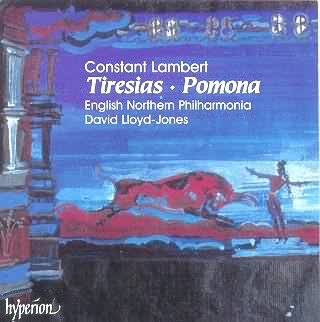
Two ballets from Constant Lambert; both enjoying their premieres on CD and in the case of Tiresias its premiere in any commercial medium.
Orchard serenade - sweet as a nut. Links with Finzian woodland inspirations. The coranto is very neo-classical. Taps into a vein explored by Warlock in the almost contemporaneous Capriol Suite. Lambert conducted one of the earliest recordings of Capriol. There are also parallels with Moeran's orchestral Serenade from twenty years later. The Passacaglia is very Finzian indeed and an easily accessible track with a cleanly emotional message with a climax almost identical to his other strong work dating from the same year (Music for Orchestra). Gently rocking siciliana. Very much a ballet of serenading woodwind tuning not so much a merry note as a contentedly sad lyric note. The slashed and chivalric Marcia has a busy Portsmouth Point dash but with echoes of neo-classical Stravinsky.
Tiresias is an enigma and a major one. Except for those who have memories of the performances during the 1950s the work remained a closed book until it was opened by the BBC. This revival took place during at a BBC Concert Orchestra studio recording conducted by Barry Wordsworth on 8 November 1995. Almost a quarter of a century on from Pomona and his best known works Lambert's accent, rather than his language, had changed. The vowels are slightly more clipped and in place of the more relaxed open-ness of Rio Grande there is a tightness and concentration which is not as immediately attractive as the language he uses in Music for Orchestra and the ballet Horoscope. This is accentuated by the scoring. The orchestra has no violins or violas. Instead the rich tones of the woodwind, glorious brass and tempered percussion (including two orchestral whips) dominate. The first five minutes are as marked maestoso, grand and commanding. The work opens with a grim fanfare and a piano flourish topped off with a whipcrack. The piano plays an important and prominent role in the 50 minute score. Falla in the scene 1 vivo. Typical jazzy dance in Bacchanale [22] very much à la Horoscope - and this really dances. Various tributes are noticeable throughout the work. I certainly heard references to Bax (Winter Legends), the Hanson symphonies (could Lambert really have heard symphonies 1-3 or is it just a coincidence?) and in Interlude [25] there plain as anything is Walton's dizzily virtuosic Sinfonia Concertante for piano and orchestra. The music is so vividly pictorial I wondered whether Bernard Herrmann had ever seen the score. The orchestration is typically Herrmann in its challenge to accepted instrumentation and the clanging piano reminded me of Havergal Brian also. This is a rich work but one which requires some persistence to pierce the initially unpromising exterior veil.
The exemplary notes are by Lewis Foreman who reminds us how exciting the BBC programmes conducted by Lambert during the period 1930-1951 were. What a tragedy that they do not survive on transcription discs although Mr Foreman does mention that the odd fragment does exist.
The cover art from the original production of Tiresias is by Isabel Rawsthorne (Lambert's widow).
A small point which shows Hyperion's attention to detail. They seem to have chosen a supplier of jewel cases who has solved the problem of fragile broken central stems. The circle of 'pegs' are supported by a central o ring. It looks a good design to me and shows some thought for customers.
This CD belongs in the collection of every serious collector of British music, of ballet music of the 20th centruy and of anyone at all entranced by Lambert's muse. If you do not know Lambert's voice then start with Rio Grande and then move onwards to the ballets. His masterwork is Summer's Last Will and Testament and conveniently both Rio and Summer are coupled on another Hyperion CD (CDA66565).
Now Hyperion how about Lambert's succinctly symphonic but hideously titled Music for Orchestra? It plays for only 18 minutes and could be coupled with the brief Dirge from Cymbeline plus Merchant Seaman with as much of the music as you can trace and reconstitute, the orchestral Elegiac Blues and a suite of music from Anna Karenina.
The strongest recommendation for a generous CD and one in the forefront of adventurous programming.
Reviewer
Rob Barnett

JOHN MCLEOD Piano Music. Twelve Preludes/Hebridean Dances/Four Impromptus/Piano Sonatas 1/3 Murray McLachlan, piano.
Redbook Records RBCD002
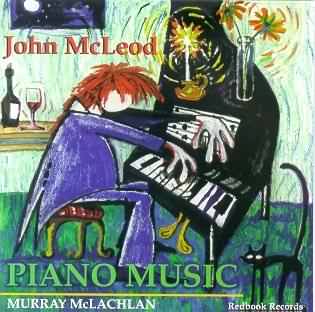
This is a welcome disc. Not only do I recommend its purchase but that recitalists take up McLeod's best piano music.
Writing for the piano is many composers' Achilles heel. In the final analysis few composers can write really effectively for the piano. Among the British composers still happily with us, Francis Routh is possibly one of the finest composers for the piano and, certainly, John McLeod is another.
So much piano music today is of the static and tedious variety, a sort of updated melancholic dreamy expression of a few famous names from the beginning of the nineteenth century when, although piano music was tuneful, it meandered and, perhaps, sometimes wallowed. But this CD is, in the main, of real piano music and while the quality of the music varies from uneventful to excellent, it must be remembered that no composer can compose music of supreme quality all the time.
The Twelve Preludes are exceptional. The theme of the opening prelude has remained with me since I heard it. There is a finely judged balance of virtuosity and excitement and thoughtfulness. But the great thing is that the work is always full of interest; it is never static or dull.
It is one of the most rewarding piano works I have experienced for a long time.
The Piano Sonata No 1 is a compact work in a single movement. After an introduction we have a fast-slow-fast format. The continuity does not always seem to be there but watch out for the final pages. Of these I can, in all truth, use the word brilliant correctly. It is very exciting indeed.
Arrangements of Hebridean folk dances follow. Dressed in 'unexpected' harmonies and a craggy ruggedness which may not appeal to everyone and there is always that group of listeners who spend their time 'trying to find the tune' rather than paying attention to the music. The Harp of Dunvegan is superbly realised.
One of McLeod's earliest compositions is the Four Impromptus of 1966. The work is dedicated to his then-teacher Lennox Berkeley. These four pieces are nothing like the Schubert Impromptus. We are not in the realms of pretty melodies and endless repetitions but direct statements and communication. What I discovered was that the descriptions of each of the four pieces were perfectly apt: energico, tranquillo, cantabile and risoluto.
The Piano Sonata No 3 dates from 1995. It uses a quotation from Scotland's Renaissance composer, Robert Carver. The episodic style greatly hinders the logic and continuity of the piece. It is a work of depths that I cannot yet fathom and there are exciting bursts of powerful virtuosity but I was left with a conviction that, while this work is expertly pianistic, it may fare better in an orchestral dress. In my view, the piece needs more colour. I found it a little tedious.
Murray McLachlan needs no further words from me as to his reliable, exciting and exemplary performances. The recording was bright but my copy of the CD kept sticking.
Reviewer
David Wright
Performances

Recording

see also previous review by Colin Scott-Sutherland
MENOTTI Violin Concerto, BARBER Violin Concerto Ruggiero Ricci (violin) Pacific SO/Keith Clark
rec issued 1992 REFERENCE RECORDINGS RR-45CD
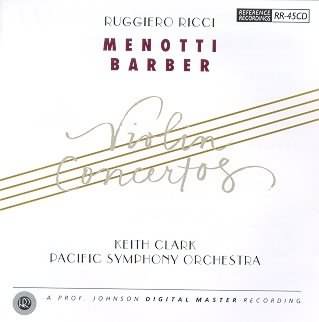
The Menotti was premiered by Efrem Zimbalist on 5/6 December 1952 with the Philadelphia conducted by Ormandy. It is an aristocratically romantic work with not a hint of over-the-top romance. You need have no fears that this is going to be as luxuriant as the Korngold of five years previously. The romanticism is flowingly done by Ricci without the shrill fire of the 1955 LP recording (Tossy Spivakovsky with the Boston SO conducted by Charles Munch).
The first movement is glowingly melodic and though marginally over-stretched it uses a rather lovely idea. The second movement is reflective of course and here the links with its disc-mate, the Barber concerto, come over strongly. The work is old-fashioned and its kinship is with Sibelius and Tchaikovsky. Only in this middle movement, with its slightly discordant fanfares, does a feint whiff of modernism enter the proceedings, soon dispelled (3:53) by a tentative French après-midi interlude. This in turn gives place to a quicksilver cadenza melting back into an episode of veiled beauty carried by ecstatic strings. The playful finale has hints of the Prokofiev first concerto. The shade of Balakirev's Tamara appears (2:00) in the form of a slave dance as the violin sings with reserve and rapt adoration over rhythmic drumming. If you like romantic violin concertos (Tchaikovsky, Sibelius, Barber, Ivanovs, Karlowicz) you are seriously missing out if you do not hear this. A classic of the twentieth century.
Almost fifteen years before the Menotti premiere, the Philadelphia and Ormandy partnered Albert Spalding in the first performance of the Barber Concerto, a work that has held its place in the repertory and for a while was represented by the CBS LP. Of course we are not short of performances of the Barber Concerto. This one is given a reflectively nostalgic rather than a hectically quick-fire performance. Do not misunderstand: there are fireworks but a longer view is the hallmark of the approach. Listen for example to the long drawn pause out in the first movement at 3:58. This is daringly slow but Ricci and his conspirators succeed and at the same time lay bare the bones of the Barber work more effectively than many a hot-shot performance. The contours are warmly detailed and the colours give off a luminescence which is only hinted at elsewhere. Ricci's half-hooded tone at 11:03 is compulsively listenable.
The slow movement is played lingeringly; somehow like a lover's wondering watch in the depths of a moonlit night over the sleep of their partner. (Sorry for the fanciful language; it is that sort of work.) The oh-so-hesitant distant fanfares in the centre of the movement inject a moment's foreboding but all settles back again into the nightwatch. The flighty presto has the same qualities and here the steady hand caused me a few misgivings. It could have done with greater speed. While noticeably quick it is clear that Ricci is taking his time to admire and suffuse the landscape with his own colours and textures. Once again however there are real gains in the definition of ideas. All too soon the movement ends but then this movement always struck me as too perfunctory (even at this speed) by comparison with its predecessors.
The technical side is lovingly handled by Reference Recordings who clearly relished Ricci's mesmerically detailed approach. If you have rather tired of dash, rush and flashy stridency in this work then this is the disc for you.
I quibble over playing time which seems short by the side of many issues these days. The musical and technical quality is however undeniable. This will be the connoisseurs' recording of choice in years to come. A sleeper in relation to the Barber and an enduring hit in the case of the unfairly neglected Menotti. Now how about a disc of the Menotti concertos including the piano concerto and the triple concerto?
Reviewer
Rob Barnett

NIKOLAI MIASKOVSKY (1881-1950) Cello Concerto in C minor (1944) 36.49, Cello Sonata No. 1 in D major (1946?) 20.09, Cello Sonata No. 2 in A minor (1949) 21.58 Kyrill Rodin (cello), Andrei Pisarev (piano), Russian PO/Konstantin Krimets
ARTE NOVA Classics 74321 54464 2 [79.07] superbargain price
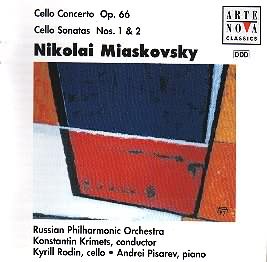
We should not hold against the cello concerto that it won the Stalin Prize. It is a challengingly elegiac work (written six years before the composer's death and in the depths of Second World War); predominantly slow and ruminant; aristocratically sad in a Medtnerian fashion. There is little circus showmanship or obvious blood-tingling excitement. The music is subtle and the leaves of Autumn settle across its subdued landscape in a soft golden rain. The sombre splendour of the lower strings and plaintive bassoon bring clear parallels with the clouded concentration of Tchaikovsky's Pathétique whose last movement is virtually carried on by the first movement of the Miaskovsky work. The Concerto ends in the high harmonics of the strings - a magical atmosphere for those prepared to persist with a work which is a rhapsodic poem for cello and orchestra rather than a virtuosic display vehicle (though there is a jerkily heroic quick section in the middle of the work). Rodin and the orchestra seem to be fully engaged by the music and while more celebrity names may claim your attention you would be well advised to try this performance. You will be agreeably surprised especially if you like the Delius concerto ... and the Miaskovsky is a work of greater melodic distinction.
The first cello sonata comes from a few years later than the concerto and also is in two movements. It was written over a period of 24 years. A strongly marked out singing theme is one of the highlights of the work. It also draws on a rich vein of ecstasy in song (e.g. 4.50 in first movement). The last movement has a burning urgency and it is in this movement that I thought the piano could have sounded more rounded. The final bars are wholehearted and heavily accented.
The three movement second sonata is nostalgic (how could it be anything else with Miaskovsky) but also admixes a song in constant flight. The second movement is an andante cantabile which lovers of the Bax and Rachmaninov cello concertos will want to add to their collections. Fleetly quicksilver it flows like molten gold and here Rodin's rich tone pays dividends. The finale is flashy but musically sustaining. All in all, quite a discovery for the adventurer.
The CD could hardly have been better filled although the notes (short and competent) by Yvonne Drynda, could easily have been longer with space for more information. They are in the usual German, English and French.
I would like to have been able to compare it with Olympia OCD530 (Marina Tarasova with the Moscow New Opera Orchestra) but unfortunately a review copy was not available. This is a pity as the coupling is identical. However the Olympia is at full-to-medium price and the present disc is at superbargain.
I am not sure that these works are the best place to start with Miaskovsky although his cello concerto made his name and kept it in the EMI lists for many years with Rostropovich playing and Sargent conducting the RPO.
Recommended.Reviewer
Rob Barnett

MUSSORGSKY Pictures at an Exhibition; Ravel Miroirs Andreas Boyde (piano)
DDD Athene-Minerva. ATHCD17 [65' 05"].
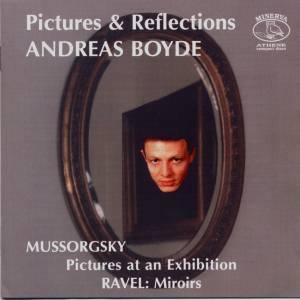
From the very first notes of the Mussorgsky I knew that this was going to be an exceptional performance. I was proved to be right. The clarity of the playing was crisp and well articulated and, what was so refreshing and welcome, was the pianist's excellent judgement of tempi which is one of the secrets of a successful performance of this heterogeneous work. The skill and technique is undeniable and, although I have known this inspiring work for 40 years the detail that Boyde reveals is quite astonishing as are the superlative nuances he achieves. The linking Promenade is not played as if the visitor to the gallery is bored but enthusiastic; some may carp about Bydlo being heavy but what I also enjoyed was the pianist's confidence in the music; he is not ashamed or embarrassed about the composer's 'wrong notes' . He has an enviable ability for light and shade and is totally convincing. The Ballet of the Unhatched Chicks sizzles remarkably ... one can but admire his pianistic skills.
I waited with some apprehension for the final movement The Bogatyr Gate at Kiev which, because of the unhurried nature of the grand tune, can sound hesitant and unconvincing as, indeed, can the Catacombs movement. But I should not have worried. His wise use of pedal notes and contrast was so good that I felt I had heard this for the first time. He displays much insight into this piece; it is carefully thought out and all the better for it.
The Ravel pieces are far more pianistic and call for all and every constituent facet that a truly great performer needs. In addition, we have in Andreas Boyde a very mature performer but his performances are never dull or those of a tired or mechanical player. It is only after hearing his account of Oiseaux Tristes that I discovered how amazing this piece is. Any artiste that can convey that level of communication coupled with such consummate skill and breathtaking ability is destined to become famous and rightly so. He is already a brilliant star. His command of the piano is staggering!
Readers may be interested to know that Andreas is to premiere a new work in New York in October ... Schumann's Variations on a theme of Schubert.
The recording quality is excellent. The range from pp to fff is wide.
A superb disc in every way!
Reviewer
David Wright
Performances

Recording

Giacomo PUCCINI (1858-1924) IL TRITTICO: Il Tabarro (The Cloak); Suor Angelica (Sister Angelica)*; Gianni Schicchi. Roberto Alagna; Angela Gheorghiu; Carlo Guelfi; Maria Guleghina; Cristina Gallardo-Domâs; Bernadette Manca Di Nissa; Felicity Palmer; Neil Shicoff; José Van Dam; Tiffin Boys' Choir; London Voices; London Symphony Orchestra; Philharmonia Orchestra* conducted by Antonio Pappano
EMI CDS5 56587 2 [52:56] [55:45] and [53:16]
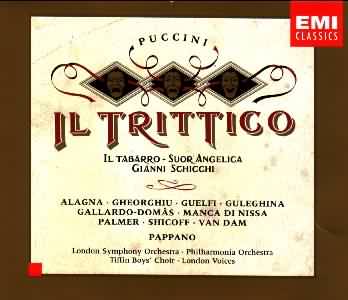
This magnificent new Pappano release is a worthy successor to his 1997 recording of Puccini's La Rondine that won Gramophone's 'Record of the Year' accolade. Again, Alagna and Gheorghiu are starred but this time in an ensemble cast. The duo star only in Gianni Schicchi, as the young lovers, Rinuccio and Lauretta. In Il Tabaro they have a minor, background role as two lovers strolling along the banks of the Seine. Rather than weakening the production by having Gheorghiu singing the lead roles in all three operas, the notion of having three separate sopranos provides a welcome diversity of tone and that strengthens the whole.
I treasure those recordings of the three single-act operas made by EMI in the 1950s, that were gathered together in the box set released by EMI in 1992 (CMS 7 64165 2). Tito Gobbi was unforgettable as the tragic, tormented Michele in Il Tabarro and wryly comic as Gianni Schicchi; and Victoria De Los Angeles had a luminous beauty as Suor Angelica. This new complete recording of Il Tittico, however, must now be regarded as the benchmark recording.
Pappano again shows his mastery of the Puccini idiom. He breathes life and credibility into these three diverse stories, realising all Puccini's little, yet revealing subtleties and nuances and delivering beautifully structured performances that are ideally paced so that the emotional climaxes have tremendous power. He is aided by first class engineered sound with wide perspectives and dynamics. The opening of Il Tabarro, for instance, is a vivid evocation of evening on the banks of the Seine with the busy street-life of Paris, around Michele's barge, slowly winding down; just as the serenity of the convent gardens with its birdsong and fountains is magically captured at the beginning of Suor Angelica.
In Il Tabarro, Carlo Guelfi, as Michele, may not dispel memories of Gobi but he characterises very well the essential warmth of the cuckolded barge-master as well as his jealousy and cruelty. He makes his duet with his wife Giorgetta (Maria Guleghina) superbly poignant as he tries to make her remember their dead baby and the days when they were happy together. Guleghina and Shicoff (as Luigi, Giorgetta's doomed lover) are also well cast and convincing as they sing their duet wishing they could be free of Michele and his barge to enjoy life together in Paris.
The young Chilean soprano Cristina Gallardo-Domâs is a radiant Sister Angelica and she sounds rather younger than many sopranos who have approached this role. This is no bad thing because one can imagine a very young girl being led astray and having to pay the price of having an illegitimate baby by being banished to a nunnery. But Gallardo-Domâs shows not only Sister Angelica's kindness, warmth and compliance and piety, but also her defiance in the scene where she is rebuked by her icily implacable aunt, the princess (frostily sung by an appropriately imperious Bernadette Manca di Nissa). The climactic miracle scene, when after taking poison in a fit of madness, and appealing to the Virgin Mary, Sister Angelica is granted absolution and is reunited with her dead infant as she dies, is breathtakingly beautiful. I cannot remember having been as moved by this scene before - a tribute to Pappano's skill in treading the fine line between the beatific and the mawkish.
As Gianni Schicchi, José van Dam once again proves what a great singer/actor he is - all the wry cunning and sardonic wit implicit in this role is realised. Gheorghiu is beguiling, subtle and delicate in her big aria 'O mio babbino caro'. Alagna impresses with his enthusiastic paean to Florence in his aria 'Firenza è come un albero fiorito' (Florence is like a tree in flower). And together they sing radiantly of their love triumphing at the close of the opera. The supporting cast all shine as the greedy grasping relatives of the deceased Buoso Donati - all keen to get their hands on his wealth.
Recommended most strongly
Reviewer
Ian Lace

There are more >>>>>
![]() COMPETITION WIN
a CD of your Choice from Crotchet
COMPETITION WIN
a CD of your Choice from Crotchet
![]()
 Search the Crotchet database from here
Search the Crotchet database from here
| Discs
on these pages are offered for sale. There is also a page of search
engines from a selection of on-line retailers
here.
Please support this web-site by buying your discs here. Disclaimer: Every effort is made to make sales links to the correct disc but, in the end, you must take responsibility for checking that what you are purchasing is what you want. Some of these discs were not actually available for sale at the time of posting but a link has been made in anticipation of their forthcoming availablility. |
Return to Index